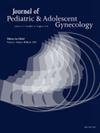7. Fertility Attitudes and Turner Syndrome
IF 1.8
4区 医学
Q3 OBSTETRICS & GYNECOLOGY
引用次数: 0
Abstract
Background
Primary Ovarian Insufficiency is the main reproductive effect in individuals with Turner syndrome (TS). Guidelines recommend disclosure of reduced fertility in individuals with TS and counseling inclusive of options for fertility preservation and family planning. Although ovarian tissue cryopreservation (OTC) and oocyte cryopreservation (OC) are offered to individuals with TS, live births rates remain unknown. Also unknown are the attitudes of adolescents and young adults with TS (AYA-TS) and their parents regarding future fertility. The objective of this study was to compare differences in attitudes between AYA-TS and their parents regarding future fertility and fertility preservation.
Methods
After IRB approval, we conducted two studies in sequence of 12- to 25-year-olds with TS and their parents. First, to maximize acceptability/applicability of the Fertility ConcepTS questionnaire, a two-staged Delphi Procedure was implemented during 3 focus groups with AYA-TS and parents to develop/ refine survey questions. Second, a finalized cross-sectional survey was distributed via a social media platform of the Turner Syndrome Global Alliance and during a multidisciplinary TS clinic. Statistical analysis was performed using SPSS. Statistical significance was defined as P <.05.
Results
A total of 28 participants were included in the analysis. Sixteen (57%) were AYA-TS and 12 (43%) were parents (Table 1). The median age of AYA-TS was 17.5 (IQR 10.5) years and of parents was 48.0 (IQR 9.3) years. AYA-TS and parents did not differ in their interest in understanding the effects of TS on fertility and pregnancy, their interest building a family, their desire for awareness of the possibility of biological children, and their awareness that feelings about building a family might change (Table 2). AYA-TS and their parents differed in their consideration for adoption (p=.005), use of donor egg (p<.001), use of a gestational carrier (p<.001) and raising a child as a single parent (p=.002). While 6.3%, 18.8%, 37.5% and 31.3% of AYA-TS disagreed/strongly disagreed with adoption, donor egg, gestational carrier, and single parenthood, respectively, all parents agreed/strongly agreed. AYA-TS and their parents differed in their consideration for OC (p=.042), OTC (p=.021), and awareness of change in opportunity for OC/OTC (p=.002). Although all parents agreed/strongly agreed, 18.8%, 43.8%, and 18.5% of AYA-TS, respectively, disagreed/strongly disagreed with OC, OTC, and awareness of change in opportunity for OC/OTC.
Conclusions
AYA-TS and their parents have differing attitudes about fertility and fertility preservation. Counselling should include consideration of the needs of AYA-TS alongside parent priorities.
7.生育态度与特纳综合征
背景原发性卵巢功能不全是Turner综合征(TS)患者的主要生殖影响因素。指南建议披露TS患者生育能力下降的情况,并提供包括保留生育能力和计划生育选择在内的咨询。虽然卵巢组织冷冻保存(OTC)和卵母细胞冷冻保存(OC)提供给TS患者,但活产率仍然未知。同样未知的是青少年和年轻成人的TS (AYA-TS)和他们的父母对未来生育的态度。本研究的目的是比较AYA-TS和他们的父母对未来生育和生育保留的态度的差异。方法经IRB批准后,我们对12- 25岁的TS患者及其父母进行了两项研究。首先,为了最大限度地提高生育概念问卷的可接受性/适用性,在与AYA-TS和父母的3个焦点小组中实施了两阶段的德尔菲程序,以开发/完善调查问题。其次,通过特纳综合征全球联盟的社交媒体平台和在多学科TS临床期间分发最终的横断面调查。采用SPSS进行统计分析。统计学意义定义为P <; 0.05。结果共纳入28名受试者。16例(57%)为AYA-TS, 12例(43%)为父母(表1)。AYA-TS的中位年龄为17.5 (IQR 10.5)岁,父母为48.0 (IQR 9.3)岁。在了解TS对生育和怀孕的影响的兴趣、建立家庭的兴趣、意识到生儿育女可能性的愿望以及意识到建立家庭的感受可能发生变化方面,AYA-TS和父母没有差异(表2)。AYA-TS和父母在考虑收养(p= 0.005)、使用捐赠卵子(p= 0.001)、使用妊娠载体(p= 0.001)和单亲抚养孩子(p= 0.001)。对于领养、捐赠卵子、妊娠载体、单亲,分别有6.3%、18.8%、37.5%和31.3%的家长表示不同意/非常不同意,但所有家长都表示同意/非常不同意。青少年青少年和他们的父母在考虑OC (p= 0.042)、OTC (p= 0.021)和对OC/OTC机会变化的认识(p= 0.002)方面存在差异。尽管所有家长都同意/非常同意,但分别有18.8%、43.8%和18.5%的家长不同意/非常不同意OC、OTC以及对OC/OTC机会变化的认识。结论saya - ts及其父母对生育和保留生育能力的态度存在差异。咨询应考虑到家长优先考虑的同时,也要考虑到青少年青少年服务的需要。
本文章由计算机程序翻译,如有差异,请以英文原文为准。
求助全文
约1分钟内获得全文
求助全文
来源期刊
CiteScore
3.90
自引率
11.10%
发文量
251
审稿时长
57 days
期刊介绍:
Journal of Pediatric and Adolescent Gynecology includes all aspects of clinical and basic science research in pediatric and adolescent gynecology. The Journal draws on expertise from a variety of disciplines including pediatrics, obstetrics and gynecology, reproduction and gynecology, reproductive and pediatric endocrinology, genetics, and molecular biology.
The Journal of Pediatric and Adolescent Gynecology features original studies, review articles, book and literature reviews, letters to the editor, and communications in brief. It is an essential resource for the libraries of OB/GYN specialists, as well as pediatricians and primary care physicians.

 求助内容:
求助内容: 应助结果提醒方式:
应助结果提醒方式:


